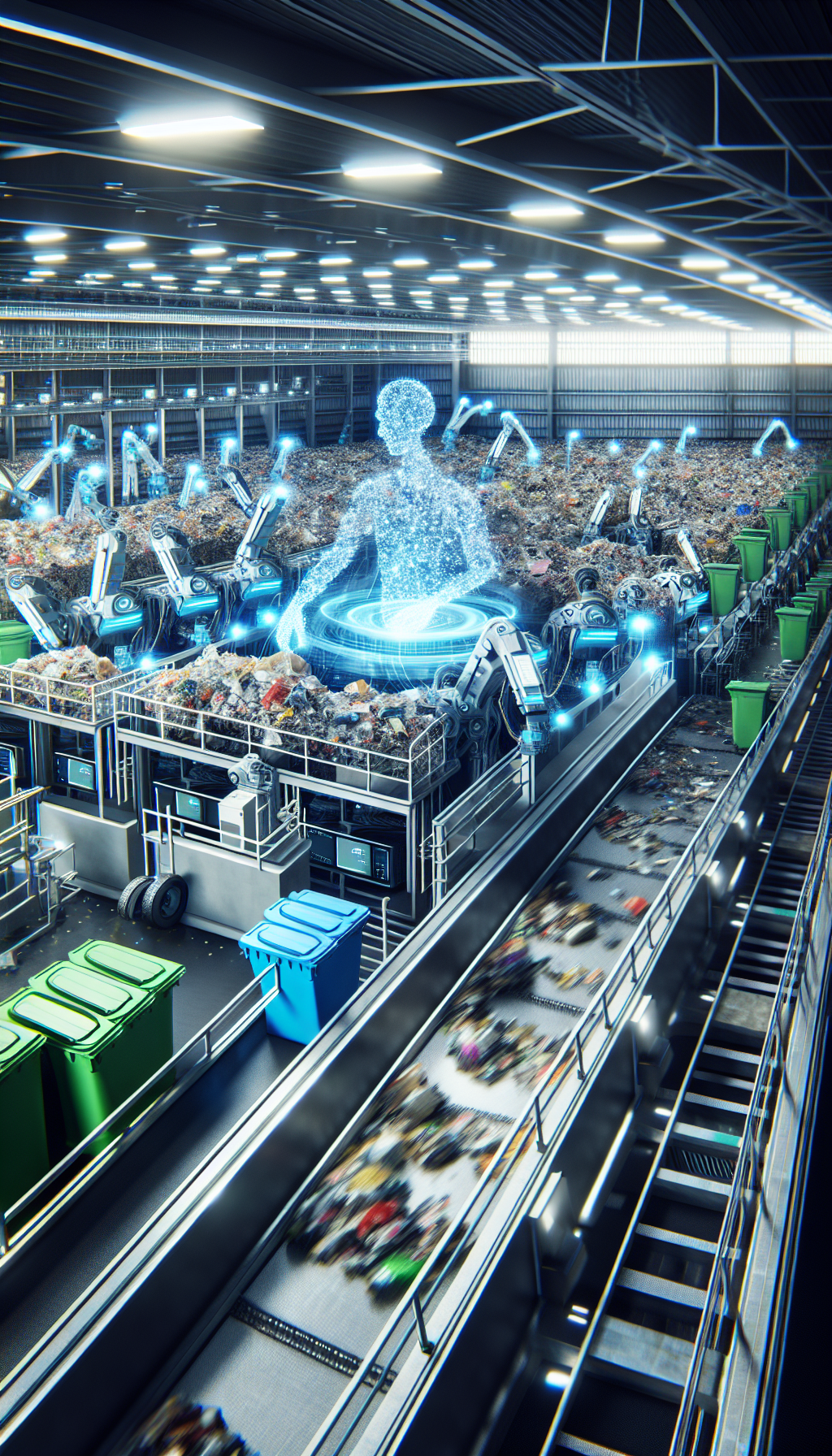The Role of AI in Modern Recycling
Artificial Intelligence (AI) is playing a pivotal role in modern recycling processes, significantly enhancing the efficiency and effectiveness of waste management systems. With the increasing complexity of waste streams, traditional methods are often inadequate to achieve high levels of resource recovery. AI-driven technologies such as machine learning algorithms and computer vision systems are being integrated into recycling facilities to optimize sorting processes and minimize contamination.
One of the key applications of AI in recycling is through automated sorting systems. These systems utilize advanced sensors and AI algorithms to identify and separate materials with high precision. For example, computer vision technology can distinguish between different types of plastics, metals, and paper products, ensuring that each material is directed to the appropriate recycling stream. This reduces the reliance on manual sorting, which is not only time-consuming but also prone to errors.
- Increased Efficiency: AI systems can process large volumes of waste more quickly than human workers, leading to higher throughput rates and reduced operational costs.
- Improved Accuracy: With advanced recognition capabilities, AI can achieve a sorting accuracy of over 95%, significantly reducing contamination rates.
- Data-Driven Insights: AI provides valuable data on waste characteristics and trends, enabling better decision-making and strategic planning for recycling facilities.
Furthermore, AI contributes to predictive maintenance of recycling equipment. By analyzing patterns and anomalies in machine performance data, AI can predict potential failures before they occur, allowing for proactive maintenance and reducing downtime. This not only extends the lifespan of equipment but also ensures uninterrupted recycling operations. As AI technology continues to evolve, its integration into modern recycling systems promises to further drive sustainability and efficiency, supporting the overarching goal of a circular economy.
| AI Technology | Application in Recycling | Benefits |
|---|---|---|
| Machine Learning | Optimizing sorting algorithms | Increased accuracy and efficiency |
| Computer Vision | Material identification and classification | High precision sorting |
| Predictive Analytics | Maintenance scheduling and downtime reduction | Extended equipment lifespan |
AI-Powered Waste Sorting Technologies
AI-powered waste sorting technologies are at the forefront of transforming the waste management industry, offering unprecedented accuracy and efficiency in identifying and separating materials. These technologies utilize machine learning algorithms and computer vision systems to automate the sorting process, which traditionally relies on human labor. By reducing human intervention, AI systems not only enhance productivity but also minimize errors, leading to a more streamlined waste management process that supports sustainability goals.
One of the key advancements in this field is the use of robotic arms equipped with sensors and cameras that scan and sort waste materials on conveyor belts. These systems can identify various types of waste, such as plastics, metals, and paper, with remarkable precision. For instance, AI-driven sorting systems have been shown to achieve over 90% accuracy in material identification, significantly surpassing the capabilities of manual sorting. This high level of precision ensures that more materials are recycled appropriately, reducing contamination rates and enhancing the quality of recycled products.
The implementation of AI in waste sorting is also supported by data visualization tools that provide real-time insights into the sorting process. These tools help operators monitor system performance, track sorting efficiency, and identify potential bottlenecks. For example, a typical dashboard may display data such as the volume of waste processed, the percentage of each material type sorted, and the error rate of the sorting system. This information is crucial for making informed decisions about system optimizations and ensuring continuous improvement in sorting operations.
Moreover, AI-powered waste sorting technologies play a significant role in advancing circular economy initiatives. By improving the accuracy and efficiency of sorting processes, these technologies facilitate the recovery of valuable materials that can be reintroduced into the production cycle, thus closing the loop of resource utilization. As a result, AI-driven systems not only contribute to reducing landfill waste but also support the creation of a more sustainable and resilient economy.
Enhancing Efficiency in Recycling Plants
The integration of AI technologies in recycling plants significantly enhances operational efficiency by streamlining sorting processes and optimizing resource allocation. AI-driven sorting systems utilize advanced machine learning algorithms to accurately identify and categorize waste materials. This precision not only reduces contamination rates but also increases the overall throughput of recycling facilities. By employing computer vision and sensor fusion techniques, these systems can distinguish between various types of plastics, metals, and paper, ensuring that each material is processed correctly.
One of the key benefits of AI in recycling is its ability to adapt and learn over time. As AI systems are exposed to more data, they can improve their sorting accuracy and efficiency. Data visualization tools play a crucial role in this process, providing plant operators with real-time insights into sorting performance and material flow. Through dashboards and interactive charts, operators can monitor key metrics such as sorting speed, error rates, and material recovery rates. This information enables quick decision-making and facilitates continuous improvement in recycling operations.
AI also contributes to energy efficiency in recycling plants. By analyzing data from various sensors, AI systems can optimize the operation of machinery, reducing energy consumption and minimizing downtime. Below is a table illustrating the impact of AI on energy savings in recycling plants:
| AI Technology | Energy Savings (%) |
|---|---|
| Automated Sorting | 15% |
| Predictive Maintenance | 20% |
| Resource Allocation | 10% |
In conclusion, the deployment of AI technologies in recycling plants not only enhances efficiency but also supports sustainability goals by reducing waste and conserving resources. By leveraging AI, recycling facilities can operate more effectively, contributing to a circular economy and advancing zero waste initiatives.
AI and the Circular Economy
Artificial Intelligence (AI) is playing an increasingly pivotal role in advancing the circular economy, a model focused on eliminating waste and the continual use of resources. By leveraging AI, industries can transition from a traditional linear economy, characterized by a ‘take, make, dispose’ approach, to a more sustainable circular model. This not only enhances resource efficiency but also minimizes environmental impact. AI technologies can optimize resource usage, improve product lifecycle management, and facilitate the recycling process, thereby significantly contributing to the circular economy.
One of the key applications of AI in the circular economy is in waste sorting and management. AI-driven systems can accurately sort waste materials, identifying and separating recyclables from non-recyclables with remarkable precision. For instance, AI algorithms can analyze waste streams through image recognition, enabling automated sorting facilities to increase recycling rates and reduce contamination. This not only improves the quality of recycled materials but also reduces the costs associated with manual sorting.
Moreover, AI can enhance predictive maintenance and supply chain management, crucial for a circular economy. By analyzing data from sensors and connected devices, AI can predict equipment failures and optimize maintenance schedules, thus extending the lifespan of machinery and minimizing downtime. In supply chain management, AI algorithms can predict demand and optimize inventory levels, ensuring that resources are used more efficiently and waste is minimized. This level of optimization is essential for maintaining the continuous flow of materials, a core principle of the circular economy.
| Role of AI | Benefit to Circular Economy |
|---|---|
| Waste Sorting | Increases recycling rates, reduces contamination |
| Predictive Maintenance | Extends machinery lifespan, reduces downtime |
| Supply Chain Optimization | Ensures efficient resource use, minimizes waste |
Data-Driven Waste Management Strategies
Data-driven waste management strategies are at the forefront of revolutionizing how communities and industries approach recycling. By leveraging advanced data analytics, municipalities and companies can optimize waste collection routes, minimize operational costs, and improve recycling rates. Artificial Intelligence (AI) plays a crucial role in analyzing vast amounts of data generated from various sources, including sensors embedded in waste bins, GPS tracking systems, and historical waste collection records. These insights enable the development of more efficient and sustainable waste management plans.
One of the key benefits of data-driven strategies is the ability to predict waste generation patterns. AI algorithms can analyze data to forecast waste volumes, allowing waste management services to allocate resources more effectively. This predictive capability is essential for maintaining the balance of the circular economy model, where the aim is to keep resources in use for as long as possible. For example, data analysis might reveal that certain areas generate more recyclable materials during specific periods, prompting targeted collection efforts that maximize recovery rates.
Moreover, the integration of AI in waste management facilitates real-time monitoring and decision-making. Waste management operators can receive instant alerts when bins are nearing capacity or when contamination levels exceed acceptable thresholds. This immediate feedback loop ensures that issues are addressed promptly, reducing overflow incidents and improving the quality of recyclable materials. Data visualization tools can represent these analytics through interactive dashboards, offering stakeholders a clear view of waste management performance metrics.
To illustrate, consider the following data visualization of a waste management system:
| Metric | Current Value | Target Value |
|---|---|---|
| Recycling Rate | 45% | 60% |
| Waste Collection Efficiency | 80% | 95% |
| Contamination Levels | 15% | 5% |
This table provides a snapshot of key performance indicators, highlighting areas where improvements are needed to achieve sustainability goals. By continuously refining data-driven strategies, waste management systems can make significant strides towards closing the loop in recycling processes.
AI in Identifying Recyclable Materials
Artificial intelligence is at the forefront of enhancing the efficiency of waste recycling processes, particularly in the identification of recyclable materials. By utilizing advanced machine learning algorithms and computer vision technologies, AI systems are capable of distinguishing between various materials with remarkable accuracy. This capability significantly reduces the reliance on manual sorting, which is often labor-intensive and prone to human error. As a result, AI-driven systems help streamline operations and increase the throughput of recycling facilities.
One of the primary techniques employed by AI in this domain is the use of image recognition technology. This involves training AI models on vast datasets of waste images, allowing the systems to learn and identify distinct material characteristics, such as color, shape, and texture. For instance, AI can differentiate between plastics, metals, paper, and glass, and can even identify different types of plastics, such as PET and HDPE. This level of precision not only enhances the sorting process but also ensures higher purity rates of recycled materials, which is crucial for maintaining the quality of recycled products.
The adoption of AI in waste identification is supported by several key technologies. A notable example is the integration of robotic arms equipped with AI-powered sensors, which can sort materials at high speeds. These robotic systems use AI algorithms to process data in real-time, enabling them to make swift and accurate decisions about material classification. The implementation of such technologies leads to a significant reduction in waste contamination and optimizes the recycling loop, thereby supporting the circular economy and zero waste initiatives.
Furthermore, the data collected by AI systems during the sorting process can provide valuable insights into waste generation patterns and recycling efficiency. This information can be used to develop targeted strategies for waste reduction and resource recovery. By analyzing trends and anomalies in the data, recycling facilities can optimize their processes, reduce operational costs, and contribute to more sustainable waste management practices.
Predictive Analytics for Waste Reduction
Predictive analytics is a powerful tool in the realm of sustainable waste recycling, leveraging data to anticipate and mitigate waste production before it occurs. By analyzing patterns and trends, predictive analytics enables waste management systems to forecast future waste generation, allowing for proactive measures to reduce waste at the source. This data-driven approach not only enhances efficiency but also supports a more sustainable and circular economy by minimizing waste and optimizing resource use.
One of the key applications of predictive analytics in waste reduction is in dynamic waste collection scheduling. By utilizing historical data and real-time inputs, waste management systems can predict the optimal times for waste collection, ensuring that resources are used efficiently. This results in fewer collection trips, reduced fuel consumption, and lower greenhouse gas emissions. Furthermore, predictive models can identify areas with high waste generation, allowing for targeted interventions to encourage recycling and waste reduction in those communities.
Another significant benefit of predictive analytics is its ability to enhance waste sorting and processing. By predicting the composition of waste streams, recycling facilities can adjust their operations to maximize the recovery of valuable materials. This not only increases the efficiency of the recycling process but also improves the quality of recycled materials, making them more attractive for reuse in manufacturing. The implementation of predictive analytics in waste management thus contributes to the overarching goal of achieving zero waste.
To illustrate the impact of predictive analytics, consider the following data points:
- Reduction in waste collection costs by up to 20% through optimized scheduling.
- Increase in recycling rates by 15% due to improved sorting accuracy.
- Decrease in landfill usage by 10% as a result of targeted waste reduction initiatives.
AI’s Contribution to Zero Waste Initiatives
Artificial Intelligence (AI) plays a pivotal role in advancing zero waste initiatives by optimizing sorting processes, enhancing material recovery, and minimizing landfill use. Through machine learning algorithms and computer vision, AI systems can accurately identify and sort recyclable materials, thereby significantly reducing contamination rates. This precision in sorting ensures that more materials are recovered and reused, aligning with the principles of a circular economy.
AI-driven technologies enable waste management facilities to process larger volumes of waste more efficiently. For example, robotic sorting arms equipped with AI capabilities can work tirelessly, achieving sorting speeds and accuracy levels unattainable by human workers alone. This automation not only improves operational efficiency but also reduces the reliance on manual labor, which can be inconsistent and costly.
Moreover, AI contributes to zero waste initiatives by providing valuable insights through data analytics. By analyzing patterns in waste generation and recycling rates, AI systems can help municipalities and businesses develop targeted strategies to reduce waste at the source. This data-driven approach supports the development of more effective waste reduction campaigns and policies.
| AI Technology | Impact on Zero Waste |
|---|---|
| Machine Learning | Improves sorting accuracy and efficiency |
| Robotic Automation | Increases processing capacity and reduces labor costs |
| Data Analytics | Provides insights for waste reduction strategies |
In summary, the integration of AI in waste management systems is instrumental in advancing zero waste initiatives. By leveraging AI technologies, we can close the loop in recycling processes, ensuring that resources are continually reused and waste is minimized. This not only supports environmental sustainability but also contributes to the economic viability of waste management operations.
Environmental Impact of AI in Recycling
The integration of Artificial Intelligence (AI) in recycling processes has significantly impacted the environment by enhancing the efficiency and effectiveness of waste management systems. By utilizing AI-driven technologies, recycling facilities can better sort and process recyclable materials, thereby reducing the volume of waste that ends up in landfills. AI-powered sorting systems are capable of identifying and categorizing various materials with high accuracy, which minimizes contamination and maximizes the recovery of valuable resources. This improvement in sorting precision not only conserves natural resources but also reduces the carbon footprint associated with traditional recycling methods.
Moreover, AI technologies contribute to the development of a more robust circular economy, where materials are continuously reused rather than discarded. The implementation of machine learning algorithms allows for the optimization of recycling operations, leading to increased throughput and decreased energy consumption. As AI systems learn and adapt, they enable recycling facilities to operate more sustainably and efficiently. This reduction in energy use directly correlates with a decrease in greenhouse gas emissions, further mitigating the environmental impact of waste processing.
To illustrate the benefits of AI in recycling, consider the following data visualization outlining the improvements in efficiency and environmental impact:
| Recycling Aspect | Traditional Method | AI-Enhanced Method |
|---|---|---|
| Sorting Accuracy | 85% | 98% |
| Energy Consumption Reduction | – | 30% |
| Carbon Emissions Reduction | – | 25% |
In addition to these quantifiable benefits, AI in recycling also facilitates better data collection and analysis, enabling more informed decision-making processes. By leveraging AI, companies can track the lifecycle of materials, forecast demand for recycled products, and design strategies that further enhance sustainability efforts. The ability to predict and respond to recycling trends ensures that resources are utilized more effectively, aligning with global zero waste initiatives.
Challenges and Limitations of AI in Recycling
While AI technology offers promising advancements in sustainable waste recycling, it is not without its challenges and limitations. One of the primary challenges is the high cost of implementation. Developing and deploying AI-driven systems require substantial financial investment, which can be a significant barrier for smaller recycling facilities. Additionally, the maintenance and upgrading of these technologies can incur ongoing expenses, further complicating their adoption.
Another significant limitation is the complexity of waste streams. AI systems rely on large datasets to accurately identify and sort materials, but the heterogeneous nature of waste can complicate data collection and analysis. Contamination of recyclables is a common issue that can lead to inefficiencies in AI sorting processes. As a result, the effectiveness of AI technology in recycling heavily depends on the quality and purity of the input materials.
There is also a limited availability of skilled personnel to manage and operate AI systems in the recycling industry. The integration of AI requires expertise in both technology and waste management, and there is currently a shortage of professionals with the necessary skill set. This gap in expertise can slow down the adoption of AI solutions and hinder their potential impact.
Lastly, there are ethical and regulatory considerations that must be addressed. The use of AI in recycling involves the collection and processing of large amounts of data, raising concerns about data privacy and security. Furthermore, regulatory frameworks specific to AI applications in waste management are still in development, creating uncertainty and potential legal challenges for companies looking to innovate in this space.
Future Prospects: AI and Sustainable Waste Management
The future of sustainable waste management is poised for a significant transformation with the integration of artificial intelligence. AI technologies are expected to advance waste sorting processes, making them more efficient and accurate. By using machine learning algorithms, waste management systems can learn to identify and categorize materials with higher precision, thus supporting more effective recycling operations. As a result, AI-driven systems are anticipated to reduce contamination rates in recycling streams and enhance the overall quality of recycled materials.
Moreover, the adoption of AI in sustainable waste management can lead to improved resource allocation. AI can assess data from various sources, such as waste collection routes and recycling facility capacities, to optimize logistics and reduce unnecessary energy consumption. This not only lowers operational costs but also minimizes the carbon footprint associated with waste management activities. In the long run, these improvements can drive the industry towards a more circular economy, where waste is continuously repurposed and reused.
In the realm of zero waste initiatives, AI’s role is becoming increasingly crucial. By predicting waste generation patterns, AI can assist cities and companies in designing more effective waste reduction strategies. These strategies might include optimizing product designs for easier recycling or encouraging consumer behavior changes through targeted awareness campaigns. The potential for AI to provide predictive insights and actionable recommendations marks a pivotal shift towards minimizing waste production at its source.
To further illustrate the impact of AI on sustainable waste management, consider the following table which outlines potential benefits and expected outcomes:
| AI Application | Benefit | Expected Outcome |
|---|---|---|
| Automated Waste Sorting | Increased Efficiency | Higher Recycling Rates |
| Predictive Analytics | Resource Optimization | Reduced Operational Costs |
| Behavioral Insights | Consumer Engagement | Enhanced Waste Reduction |
The convergence of AI and sustainable waste management not only promises a greener future but also ensures that technological advancements are harnessed to address one of the most pressing environmental challenges of our time.



